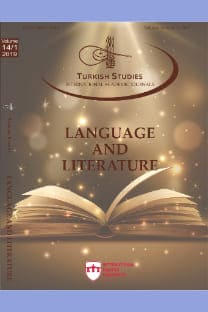Revelation and Unfolding of a Dystopian Novel: Never Let Me Go by Kazuo Ishiguro*
Distopik Bir Romanın Kurgusu ve Çözülümü: Kazuo Ishiguro’nun Never Let Me Go Romanı
___
Alban, G. M. E. (2011). The unreliable, tantalising and tormented narrators of Ishiguro’s Never let me go and The remains of the day. In H. Yıldız-Bağçe et. al. (Ed), Kazuo Ishiguro and his work (pp. 13-20). METU British Novelists Conference. Kardelen.Boschetti, F. (2017). Memories in Kazuo Ishiguro’s Never Let Me Go: A clone’s humanity. To Be Decided: Journal of Interdisciplinary Theory, 2, 41-57. http://tbd-journal.com/monstersarticles/boschetti
Eco, U. (1990). The limits of interpretation. Indiana University Press.
Freytag, G. (1863). Freytag’s technique of the drama: An exposition of dramatic composition and art. Elias J. MacEwan (2008) trans. BiblioBazaar.
Ishiguro, K. (2005). Never let me go. Faber and Faber.
Johansen, E. (2016). Bureaucracy and narrative possibilities in Kazuo Ishiguro’s Never let me go. The Journal of Commonwealth Literature, 51(3), 416–431. https://doi.org/10.1177/0021989415574137
Matthews, S. (2010). ‘I’m sorry I can’t say more’: An interview with Kazuo Ishiguro. In S. Matthews & S. Groes (Eds.) Kazuo Ishiguro: Contemporary critical perspectives, (pp. 114- 125). Continuum. http://dx.doi.org/10.5040/9781472542564.0010
Nakamura, A. (2021) On the uses of nostalgia in Kazuo Ishiguro’s Never let me go. Science Fiction Studies, 48(1), 62-76. https://www.jstor.org/stable/10.5621/sciefictstud.48.1.0062
Rajiva, J. (2020). Never let me finish: Ishiguro’s interruptions. Studies in the Novel, 52(1), 75-93. https://doi.org/10.1353/sdn.2020.0008
Rigoula, S. (2010). Never let me go by Kazuo Ishiguro: Towards an interpretation of the novel with reference to possible-worlds theory [Unpublished dissertation]. Lancaster University Department of Linguistcs.
Ryan, M. L. (1991). Possible worlds, artificial intelligence and narrative theory. Indiana University Press.
Shaffer, B. & Wong, C. (2008). Conversations with Kazuo Ishiguro. University Press of Mississippi.
Semino, E. (2005). Possible worlds: stylistics applications. In K. Brown (Ed.), Elsevier Encycloapaedia of Language and Linguistics (pp. 777-782). Elsevier. http://dx.doi.org/10.1016/B0-08-044854-2/00534-4
Semino, E. (2009). Text worlds. In G. Brone, & J. Vandaele (Eds.), Cognitive poetics: Goals, gains and gaps (pp. 33-71). (Applications of Cognitive Linguistics). Mouton de Gruyter. https://dx.doi.org/10.1515/9783110213379.fm
Thomas, J. (1995). Meaning in interaction: An introduction to pragmatics. Longman. https://doi.org/10.4324/9781315842011
Wheeler, L. K. (2018, April 24). Freytag’s pyramid. Carson-Newman University. http://web.cn.edu/kwheeler/freytag.html
Wilensky, R. (1983). Story grammars versus story points. Behavioral and Brain Sciences, 6(4), 579-591. https://doi.org/10.1017/S0140525X00017520
Wong, C. F. (2011). “Ignorance, imagination, illusion and truth”: Kazuo Ishiguro’s fictional spaces. In H. Yıldız-Bağçe et. al. (Ed), Kazuo Ishiguro and his work (pp. 1-12). METU British Novelists Conference. Kardelen.
- ISSN: 2667-5641
- Yayın Aralığı: 4
- Başlangıç: 2006
- Yayıncı: ASOS Eğitim Bilişim Danışmanlık Otomasyon Yayıncılık Reklam Sanayi ve Ticaret LTD ŞTİ
Reşat Nuri Güntekin’in Roman Karakterlerinin Okuma Pratikleri
Kânûnî Dönemi Kânûnnâmelerine Bir Örnek: Âsafnâme
Selim İleri'de Reşat Nuri'nin İzini Sürmek
Çeviriye Bakış Açısı Ölçeğini Türkçeye Uyarlama Çalışması*
Dirijizmden Dramaturjiye: Reşat Nuri’nin “Bir Yağmur Gecesi” Piyesi
Reşat Nuri Güntekin’in Hikâyelerinde Yozlaşma
Bülent Ecevit’in Siyasetin Gölgesinde Kalan Şair Kimliği
Araf’takiler: 1950–1980 Arası Eşkıya Temasının Türk Romanına Yansımaları
Derleme Sözlüğü’nde Geçen “Salgın ve Bulaşıcı Hastalıklar”la İlgili Söz Varlığı Unsurları Üzerine
Reşat Nuri’de İdealizm ve Tiyatronun Birleştiği Nokta: Son Sığınak
